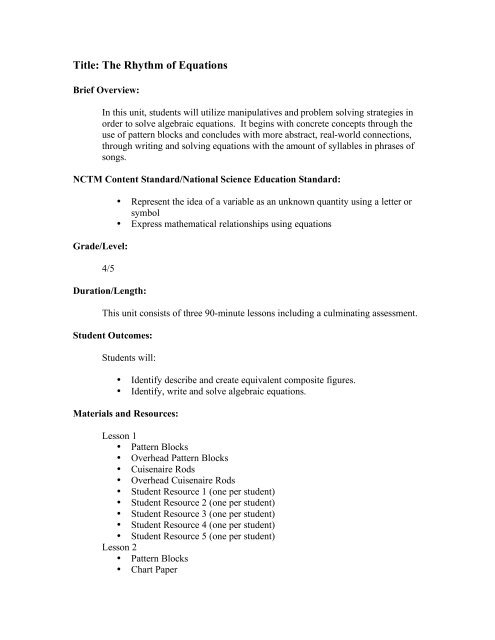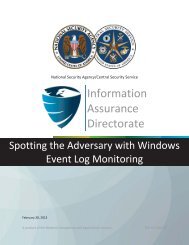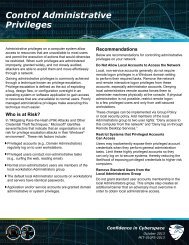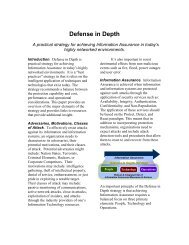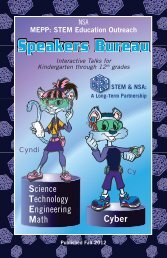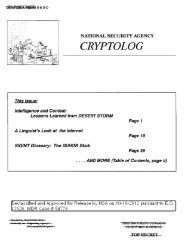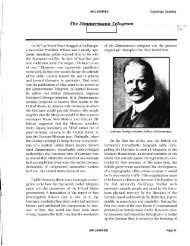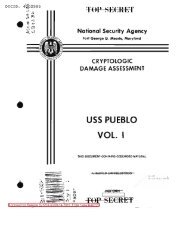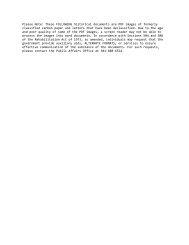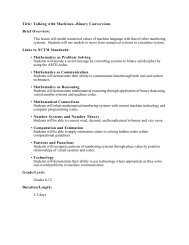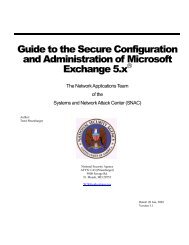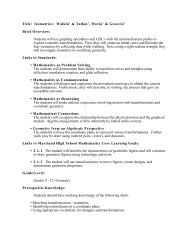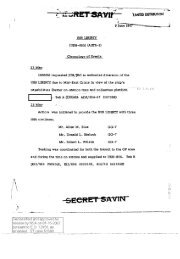Title: The Rhythm of Equations
Title: The Rhythm of Equations
Title: The Rhythm of Equations
You also want an ePaper? Increase the reach of your titles
YUMPU automatically turns print PDFs into web optimized ePapers that Google loves.
<strong>Title</strong>: <strong>The</strong> <strong>Rhythm</strong> <strong>of</strong> <strong>Equations</strong><br />
Brief Overview:<br />
In this unit, students will utilize manipulatives and problem solving strategies in<br />
order to solve algebraic equations. It begins with concrete concepts through the<br />
use <strong>of</strong> pattern blocks and concludes with more abstract, real-world connections,<br />
through writing and solving equations with the amount <strong>of</strong> syllables in phrases <strong>of</strong><br />
songs.<br />
NCTM Content Standard/National Science Education Standard:<br />
Grade/Level:<br />
4/5<br />
Duration/Length:<br />
• Represent the idea <strong>of</strong> a variable as an unknown quantity using a letter or<br />
symbol<br />
• Express mathematical relationships using equations<br />
This unit consists <strong>of</strong> three 90-minute lessons including a culminating assessment.<br />
Student Outcomes:<br />
Students will:<br />
• Identify describe and create equivalent composite figures.<br />
• Identify, write and solve algebraic equations.<br />
Materials and Resources:<br />
Lesson 1<br />
• Pattern Blocks<br />
• Overhead Pattern Blocks<br />
• Cuisenaire Rods<br />
• Overhead Cuisenaire Rods<br />
• Student Resource 1 (one per student)<br />
• Student Resource 2 (one per student)<br />
• Student Resource 3 (one per student)<br />
• Student Resource 4 (one per student)<br />
• Student Resource 5 (one per student)<br />
Lesson 2<br />
• Pattern Blocks<br />
• Chart Paper
• Index cards [10 with four different numbers on them; ten with two<br />
different numbers on them (one red, one blue)]<br />
• Student Resource 6 (one per student)<br />
• Student Resource 7 (one per student)<br />
• Student Resource 8 (one per student)<br />
• Student Resource 9 (one per student)<br />
• Teacher Resource 2<br />
• Teacher Resource 3<br />
Lesson 3<br />
• Student Resource 10 (one per student)<br />
• Student Resource 11 (one per student)<br />
• Student Resource 12 (one per student)<br />
• Teacher Resource 4<br />
• Teacher Resource 5<br />
• Teacher Resource 6<br />
Development/Procedures:<br />
Lesson 1<br />
Pre-assessment: Distribute Designing Houses (Student Resource 1)<br />
• Say: <strong>The</strong>re are two houses on this page that are the congruent. Draw<br />
shapes inside each house to fill the space. Below it record the shapes and<br />
the number <strong>of</strong> each shape you used.<br />
Launch –<br />
• Say: Today you will use pattern blocks in order to create composite<br />
figures.<br />
• Write the phrase composite figure on the board.<br />
• Say: Look at the houses you’ve created.<br />
• Ask: Were you able to completely fill the houses in a different way? Yes<br />
• Have students share their houses with other members <strong>of</strong> their tables.<br />
Allow time for them to discuss the various ways they completed their<br />
houses.<br />
• Ask for approximately 4-6 students to stand in front <strong>of</strong> the class and share<br />
their houses.<br />
• Ask: What can you tell me about these houses? How are they different?<br />
How are they the same? (Accept all possible answers) Allow students to<br />
return to their seats.<br />
• Ask: Did you notice that the outline shape <strong>of</strong> the house remained<br />
congruent? Yes<br />
• Say: This is an example <strong>of</strong> a composite figure.<br />
• On the board write and explain that a composite figure is a shape made<br />
from smaller shapes.
Teacher Facilitation –<br />
• Place overhead pattern blocks on the overhead projector.<br />
• Model for student how many triangles are in a rhombus by placing a<br />
rhombus on the overhead then placing two triangles on top <strong>of</strong> the<br />
rhombus.<br />
• Say: I have just made a composite figure <strong>of</strong> a rhombus because these two<br />
triangles create the same shape <strong>of</strong> the rhombus.<br />
• Now, place a trapezoid on the overhead and model a prediction <strong>of</strong> how<br />
many triangles it would take to completely fill the trapezoid.<br />
• Say: I can predict that it will take three triangles to completely fill this<br />
trapezoid because it took two triangles to fill the rhombus and I think one<br />
more triangle added to that will make a trapezoid.<br />
• Place three triangles on top <strong>of</strong> the trapezoid to show that your prediction<br />
was correct.<br />
• Distribute a bag <strong>of</strong> pattern blocks to each student. Each bag should have<br />
two hexagons, five trapezoids, six rhombuses and eight triangles.<br />
• Say: Now we will create composite figures using more shapes. Everyone<br />
place a hexagon on your desk. In your journal, make a prediction <strong>of</strong> how<br />
many triangles you think it would take to completely cover the hexagon<br />
shape based on what you already know. 6 (Allow one minute for<br />
students to record their predictions). Volunteer responses and<br />
explanations and record them on the board.<br />
• Say: Now, place the triangles on the hexagon to check your predictions.<br />
• Ask: Were your predictions correct? Turn and talk with someone at your<br />
table or group about what you discovered. (Allow two minutes for<br />
students to discuss. <strong>The</strong>n ask for a few volunteers to share what they<br />
learned. (Sample responses: I knew that it would take six triangles to<br />
completely fill the hexagon because it took three to cover the trapezoid<br />
and I know that the hexagon is twice the size <strong>of</strong> a trapezoid. I thought it<br />
would take five triangles to completely fill the hexagon because it was<br />
bigger than the trapezoid that took three triangles to fill it (Accept all<br />
possible responses).<br />
• Say: Now we are going to begin with a composite figure and see what<br />
other composite figure will completely fill it. Place a rhombus and a<br />
trapezoid on your desk side by side and look at it carefully. Write a<br />
prediction in your journal <strong>of</strong> how many triangles it would take to make a<br />
congruent shape. (Allow one minute for student responses in their<br />
journals).<br />
• Say: Now place the triangles on top <strong>of</strong> your composite figure to check<br />
your prediction.<br />
• Ask: Was your prediction correct? Turn and talk with someone at your<br />
table to discuss your findings. (Allow two minutes for students to discuss<br />
their results).<br />
• Ask: Are there any other shapes you could have used to make a<br />
composite figure other than only triangles? Yes
• Say: Explore with other shapes and record your findings in your journal.<br />
(Sample Responses: I found that I could use two rhombuses and one<br />
triangle. I found that I could use one rhombus and three triangles)<br />
• Say: So we can say that one trapezoid and one rhombus is equal to two<br />
rhombuses and one triangle. We can also say that two rhombuses and one<br />
triangle is equal to one rhombus and three triangles. We know they are<br />
equal because they are congruent.<br />
• Write the definition <strong>of</strong> equality on the board. (Equality: the relationship<br />
between two objects that are equal in value)<br />
• Answer questions and provide further explanation if needed.<br />
• Collect pattern blocks.<br />
Student Application –<br />
• Distribute Pattern Blocks Cut Outs (Student Resource 2) and CD Cover<br />
Worksheet (Student Resource 3)<br />
• Explain to students that a record producer has asked them to design Bow<br />
Wow’s new CD Cover. Bow Wow would like the cover to be completely<br />
covered with trapezoids, triangles, hexagons or rhombuses. Design two<br />
CD covers by completely creating two different composite figures. Below<br />
each cover list the shapes and amount that you used. <strong>The</strong>n on the lines<br />
provided at the bottom <strong>of</strong> the worksheet, explain how the two CD covers<br />
are equivalent even though they were made up <strong>of</strong> two different designs.<br />
• As students are working, circulate throughout the classroom and assist<br />
students when needed.<br />
• Allow students fifteen to twenty minutes to complete this activity.<br />
• After students have completed their assignment, have them share and<br />
describe their work. Discuss the various composite figures used to<br />
complete the CD cover.<br />
• Check to make sure students have created composite figures that are<br />
congruent to the original shape (Answers may vary depending on the<br />
number <strong>of</strong> shapes used).<br />
Embedded Assessment – BCR: (Student Resource 4 and Student Resource 5) (Teacher<br />
Resource 1)<br />
• Say: Part A: Jay-Z was so impressed by your CD cover you designed<br />
for Bow Wow that he asked you to design his as well. Based on the<br />
shapes below, create two composite figures for Jay-Z to choose from.<br />
• Part B: Explain how your CD covers are congruent. Use what you know<br />
about composite figures to explain why your answer is correct. Use<br />
letters, numbers and/or symbols in your explanation.<br />
Reteaching/Extension –<br />
• Use Cuisenaire Rods to demonstrate equivalence. Have students use the<br />
Cuisenaire Rods to create equivalent length using various sizes <strong>of</strong> rods.<br />
Students can explore and record their findings on an index card by
Lesson 2<br />
drawing and coloring what they have created with the rods onto the index<br />
card.<br />
Pre-assessment: Write the following questions on the board or on chart paper. Have<br />
students answer on slates or index cards: How many triangles does it<br />
take to make one trapezoid? [3] How do you know? [It takes three<br />
triangles to completely cover a trapezoid] Draw a diagram using the<br />
triangle, trapezoid and the equal sign.<br />
+ + =<br />
Launch – Distribute pattern blocks, (Each student should have at least six triangles, at<br />
least six rhombuses, at least six trapezoids, and at least three hexagons).<br />
• Say: Yesterday in math we learned that you could use pictures to<br />
represent equality. In math we use a lot <strong>of</strong> different things to represent<br />
equality. Today we are going to use pattern blocks and numbers to show<br />
equality using algebraic equations.<br />
• Display the correct answer to the pre-assessment on chart paper or the<br />
overhead. (See above)<br />
• Say: How are we able to use the equal sign, even though there are no<br />
numbers in our answer? How do we actually know that three triangles<br />
equal one trapezoid? (<strong>The</strong> equal sign represents balance, and we know<br />
that the shapes are equal because they are congruent, they are the same<br />
size and the same shape]).<br />
• Say: When we see the equal sign we are going to think BALANCE.<br />
Teacher Facilitation –<br />
• Ask: What if I was trying to decide what number to give each shape?<br />
Which shape do you think would be equal to one? Why? (<strong>The</strong> triangle<br />
would be equal to one because it is the smallest shape) If the triangle were<br />
equal to one, then what would be equal to two? Why? (Rhombus, because<br />
it takes two triangles to equal one rhombus]) Tell your partner the shape<br />
you predict will be equal to three? Explain your prediction. (<strong>The</strong><br />
trapezoid because there are three triangles in a trapezoid) If a triangle is<br />
equal to one, will we have a shape equal to four or five? (No) Why not?<br />
(Four or five triangles are not congruent to any other shape in our group <strong>of</strong><br />
shapes])<br />
• Say: Today we are going to learn about equations. We can use our<br />
problem <strong>of</strong> the day (pre-assessment) and turn it into an equation. Can<br />
anyone tell me how to do that? Draw the following diagram on chart<br />
paper or the overhead.<br />
3 = 3 = trapezoid
• Say: Looking at our diagram now, can anyone tell me the attributes <strong>of</strong> an<br />
equation? Solicit student responses (numbers, variables, operation, and<br />
equal sign).<br />
• Define the following four terms and place on word wall for future use.<br />
Variable: to a letter or symbol representing such a quantity.<br />
Operation: addition, subtraction, multiplication, division<br />
Equal sign: shows a relationship <strong>of</strong> balance on both sides <strong>of</strong> the sign<br />
• Distribute construction paper or a piece <strong>of</strong> unlined paper for students to<br />
use as a work mat. Have students fold paper in half twice to make four<br />
equal size squares.<br />
• Say: We already decided that one triangle was equal to the number one.<br />
But, what if I said it is no longer equal to one and instead it is equal to<br />
three. Show on your work mat = 3. Using what we know<br />
about the relationship between the shapes, we could draw a diagram<br />
showing what the rhombus is now equal to.<br />
• Display: + = and 2* =<br />
• Rhombus= 2*triangle or Rhombus = 3+3<br />
• Point to display. Ask: This is my diagram, how can I turn my diagram<br />
into an equation. What is it missing? (A variable) Let’s use the first letter<br />
<strong>of</strong> the color <strong>of</strong> the shapes to represent the actual shape, so we will make it<br />
our variable. For example, what color is the triangle? (Green Triangle=<br />
G); What color is Trapezoid? (Red Trapezoid = R) What color is<br />
Rhombus? (Blue Rhombus =B) and What color is Hexagon? (Yellow<br />
Hexagon= Y).<br />
• Say: Now let’s turn our diagram into an equation. We want the triangle<br />
to continue to equal 5 so T=5. So if we want to find out what rhombus is<br />
equal to, we could write: T x 2= R or 5 x 2 = R. Let’s check to make<br />
sure this is an equation. What are the variables in the equation T x 2= R<br />
(T and R) What is the operation? (Multiplication) What are the numbers?<br />
(2 and/or 5) Do we have an equal sign? (Yes).<br />
• Say: On your work mat please show: 8+G = 12. Show using pattern<br />
blocks.<br />
8 + =12<br />
What number can we substitute for the G? What does the G =? (4) How<br />
do you know? (Because the only number that you can insert to make both<br />
sides equal or balanced is 4).<br />
• Say: I want you to take the eight away and substitute it with a symbol or a<br />
variable, what can you predict I will replace it with? Explain your<br />
prediction. (B or a rhombus, because the rhombus is twice the size <strong>of</strong> the<br />
triangle)<br />
• Make sure students understand the meaning <strong>of</strong> the word substitute here.<br />
Put the word Substitute on the word wall. Substitute is replacing a
variable with a value. Variables stand for some value. Reiterate that<br />
substitution is the same as replacing, and you are just substituting the<br />
symbol or letter for a value.<br />
Student Application – Students will complete Student Resource 6,Variables.<br />
• Say: Now you will complete an activity sheet that is going to require you<br />
to read a key and then replace variables with numbers and numbers with<br />
variables. Make sure you read the key so that you can determine the<br />
worth <strong>of</strong> each variable. <strong>The</strong> values <strong>of</strong> the pattern blocks are set in<br />
proportion to one another, so if triangle is equal to 3 then rhombus is<br />
equal to 6.<br />
• Students will need to replace variables with numbers to show equality.<br />
Circulate the room <strong>of</strong>fering assistance when needed. Encourage students<br />
to use the pattern block manipulatives to determine proportion and<br />
equivalence.<br />
• See Teacher Resource 2,Variables, for the answer sheet.<br />
Embedded Assessment – Distribute Student Resource 07 BCR-Where Are Our Blocks?<br />
• Tell students they are going to create equations to help them solve a word<br />
problem.<br />
• Read: Marissa, Kevin, Jamal, and Tashena were playing with<br />
their pattern blocks before they went to the Bow Wow concert.<br />
Marissa’s little sister played with their blocks while they were<br />
gone. When they returned to collect their blocks Jamal noticed<br />
they were missing 4 blocks.<br />
Have students read the clues to themselves.<br />
• Ask: Are there any people who we are sure how many blocks they started<br />
with? (Yes. Marissa started with 7).<br />
• Say: Ok. <strong>The</strong>n M=7. Use this expression to help you solve the problem.<br />
Do not forget to show all <strong>of</strong> your work, and explain how you know your<br />
answer is correct. Teacher Resource 3-Where Are Our Blocks? Is the<br />
answer sheet?<br />
Reteaching/Extension –<br />
For students who have mastered the skill <strong>of</strong> equations and expressions, but need<br />
more help with variables, distribute Student Resource 08 – Pan Balance<br />
Expressions<br />
• Prepare about 10 index cards with four numbers on each. Students will<br />
take an index card and participate in the online activity Pan Balance<br />
Expressions available through the National Teachers <strong>of</strong> Mathematics<br />
worksite at: http://illuminations.nctm.org/ActivityDetail.aspx?ID=10<br />
• <strong>The</strong> goal <strong>of</strong> the activity is for students to be able to arrange the four<br />
numbers to come up with as many equivalent expressions as they can.<br />
Any <strong>of</strong> the four numbers can be X. Students can only use the numbers on<br />
the card. However, they may use they as many times as they need. <strong>The</strong>
Lesson 3<br />
students will write expressions, and then enter the expressions on the<br />
scale. If the expressions are equivalent, they will right EQUAL VALUE.<br />
If not, they will write INEQUAL VALUE.<br />
For students who need more assistance with expressions and equality, distribute<br />
Student Resource 9 Pan Balance Numbers.<br />
• Give students index cards with two numbers, one number in a red marker<br />
and one number in a blue marker. Students will participate in the online<br />
activity Pan Balance Numbers available through the National Teachers <strong>of</strong><br />
Mathematics worksite at:<br />
http://illuminations.nctm.org/ActivityDetail.aspx?ID=26<br />
• <strong>The</strong> goal <strong>of</strong> this activity is for students to be able to understand the equal<br />
sign as a relationship as opposed as to an operation or “the answer to”.<br />
Students will put the red number on the red side <strong>of</strong> the balance and the<br />
blue number on the blue side <strong>of</strong> the balance. <strong>The</strong>y will then need to create<br />
an expression on both sides that will balance. <strong>The</strong> goal is for them to<br />
come up with as many different balanced equations as they can.<br />
Pre-assessment<br />
• Say: How many syllables are in this question? 11<br />
• Say: Write another sentence that has the same number <strong>of</strong> syllables as the<br />
previous question (Students’ sentences should have 11 syllables).<br />
• Ask a few volunteers to read their sentences to the class. Record the<br />
sentences on the board.<br />
• Ask: Do all <strong>of</strong> these sentences have eleven syllables? Yes<br />
Launch<br />
• Say: Today we will be using syllables in words to write and solve<br />
algebraic equations.<br />
• Say: Yesterday, we discussed what an algebraic equation was.<br />
• Ask: Can someone refresh my memory <strong>of</strong> what an algebraic equation is?<br />
(Acceptable responses: An algebraic equation is like a number sentence<br />
because it includes numbers, an operation, and an equal sign. But an<br />
algebraic equation also has a variable). If students do not respond with<br />
similar answers, remind them to revisit the word wall before providing<br />
them with the answer.<br />
Teacher Facilitation<br />
• Write the following equation on the board. 6 + Y = 12<br />
• Ask: Is this an algebraic equation. Yes Why? (Suggested answer:<br />
Because it has a number, operation, variable and an equal sign).
• Ask: How would I solve this equation? (Suggested responses: find the<br />
missing number, use inverse operations, count backwards or count up<br />
from six until you get to twelve.)<br />
• Say: Now, look at this sentence. B + love + B = 3 syllables.<br />
• Ask: Is this an algebraic equation? Yes Why? (Suggested answer:<br />
Because it has a number, operation, variable and an equal sign).<br />
• Ask: Would I be able to solve this equation the same way as the previous<br />
equation? (Yes, you could count the number <strong>of</strong> syllables to find out how<br />
many are missing.)<br />
• (Think Aloud) Say: I am going to try to solve this equation. B + love +<br />
B = 3 syllables. Well, I will start with what I already know. I know that<br />
the word love has one syllable, so I can substitute the number one for love<br />
in this equation like this.<br />
B + love + B = 3 syllables<br />
B + 1 + B = 3 syllables<br />
• Say: Now I also know that the variable B in this equation stands for the<br />
same number because B=B. I can count up from the number one until I<br />
stop at three in order to determine what B equals. So, B = 1 because I<br />
counted up to two and I know that 1 + 1 = 2. Now, if I return to my<br />
original equation I can rewrite it with one-syllable words instead <strong>of</strong><br />
variables and complete the sentence. I + love + you = 3 syllables<br />
• Ask: Is this the only possible sentence I could have written? No<br />
• Say: Tell me other possibilities. (You love me. Accept all responses that<br />
are complete sentences with two-one syllable words.)<br />
Student Application<br />
• Say: Now we are going to try to write and solve more equations.<br />
• Write on the board: X + are + family = 5 syllables<br />
• Ask: In order for us to solve this equation, what should we do first?<br />
(Possible answer: First I would count how many syllables are in the<br />
words, are and family, and then subtract it by 5 to see how many more<br />
syllables I still need.<br />
• Write on the board below the equation, X + 1 + 3 = 5 syllables, 1+ 3 = 4,<br />
and 5 – 4 = 1 so, X = 1<br />
• Ask: What would you do to solve the equation? (Possible answer: I<br />
would think <strong>of</strong> a one-syllable word to complete the phrase.)<br />
• Write on the board, 1 + are + family = 5 syllables, so We + are + family =<br />
5 syllables.<br />
• Say: Now let’s look at how you can write your own equation from a<br />
phrase.<br />
• Write on the board, Lift + c + voice + and + sing = 6 syllables.<br />
• How can we write this phrase from a song as an equation? (Possible<br />
answer: We need an operation, variables, numbers and an equal sign. <strong>The</strong>
C is the variable. Each word value can be assigned based on its number <strong>of</strong><br />
syllables and the operation is addition.)<br />
• Write on the board, 1 + c + 1 + 1 + 1 = 6.<br />
• Ask: How do we solve for c? (Possible answer: Add all the ones and<br />
subtract the sum from six.<br />
• Write on the board, 1 + 1 + 1 + 1 = 4, and 6 – 4 = 2 so, c = 2<br />
• Take a few minutes to answer questions and provide further explanation if<br />
needed.<br />
• Distribute Lyrical <strong>Equations</strong> worksheet (Student Resource 10)<br />
Embedded Assessment<br />
• Distribute All Mixed up (Student Resource 11)<br />
• Read: <strong>The</strong> equations below represent the formula for a famous<br />
Langston Hughes poem. <strong>The</strong> poem is mixed up at the bottom <strong>of</strong><br />
the page. You have to rewrite the poem in the correct order<br />
using the equations as a guide. <strong>The</strong> equations tell you the<br />
number <strong>of</strong> syllables in each word. Write the poem in the<br />
correct order in your Math notebooks. Be sure to check your<br />
work by making sure each line matches the equation.<br />
• This form has the students doing a similar activity except now they are<br />
solving for one variable, and they have to match equations with lines <strong>of</strong><br />
poetry. <strong>The</strong> poem is mixed up. <strong>The</strong> lines are divided in syllables.<br />
Students have to put the poem in the correct order. See Teacher Resource<br />
5 for the correct answer.<br />
Reteaching/Extension<br />
Students will play online games.<br />
• Students will have to evaluate an Expression with One Variable<br />
http://www.aaaknow.com/equ725x3.htm<br />
• At this website, students will print <strong>of</strong>f a game sheet. <strong>The</strong>y will also need a<br />
number cube.<br />
http://www.bbc.co.uk/education/mathsfile/print<strong>of</strong>fs/dice1a.html<br />
Summative Assessment:<br />
<strong>The</strong> Summative Assessment for this unit is an extended constructed response,<br />
Student Resource 12- Writing and Solving a Math Song.
Authors:<br />
<strong>The</strong> students will have to write a song or poem using mathematical terms from the<br />
unit. <strong>The</strong> students will then have to convert their poem or songs into equations<br />
and write the total value <strong>of</strong> their song or poem. Students will list the variable and<br />
its value as an equation. Students will then explain how they determined the<br />
value <strong>of</strong> their song or poem, and how they developed their equations. Refer to<br />
Teacher Resource 6 for the MSA Extended Constructive Response Rubric.<br />
Tamyka Morant Samantha Kornegay<br />
Community Academy Public Charter School Allenwood Elementary<br />
Washington, DC Prince George’s County
Brief Constructed Response<br />
Teacher Resource 1<br />
Jay-Z was so impressed by your CD cover design for Bow Wow<br />
that he has asked you to design his as well.<br />
Step A<br />
Use the shapes on the back <strong>of</strong> this page to create two composite<br />
figures for Jay-Z to choose from.<br />
Step B<br />
Explain how your CD covers are equal to each other. Use what<br />
you know about composite figures to explain why your answer is<br />
correct. Use words and/or numbers in your explanation.<br />
Student answer may vary depending on the types <strong>of</strong> shapes they<br />
used and how many, however, students should include the number<br />
<strong>of</strong> shapes it takes completely cover another and explain how they<br />
are equal to one another.
Variables<br />
Directions: Rewrite each equation as a number sentence and solve.<br />
(a)If = 7 then + +<br />
=__28_____<br />
(b)If 18= then + + +<br />
=______36___________<br />
Teacher Resource 2<br />
(c)If = 36 then [ + ]<br />
=______0________<br />
(d)If = 12 then<br />
=____18_____<br />
(e) If = 5 then X +<br />
=____460_____<br />
(f) Complete the equations below using the following key:<br />
2 x G= 14 G=__7____ 36+ Y= 56-12 Y=__8______<br />
25 ÷5=36-B B=_31___ 13+H = 18- 3 H=____2____<br />
(g) Solve for each variable. Q= Quarter D=Dime N= Nickel P=Penny<br />
$5.35-[2Q * 5N] + 17 P= ____$4.77____________________<br />
$.98 * 2 + [7Q+6D] = _____$3.31______________________<br />
(h) In your own words, explain the meaning <strong>of</strong> a variable. Give an example.<br />
A variable is a letter or symbol that stands for a value. So Q can be a<br />
variable for 25 cents.
Where Are Our Blocks?<br />
Teacher Resource 3<br />
Marissa, Kevin, Jamal, and Tashena were playing with their pattern blocks<br />
before they went to the Bow Wow concert. Marissa’s little sister played<br />
with their blocks while they were gone. When they returned to collect their<br />
blocks Jamal noticed they were missing 4 blocks.<br />
Step A<br />
Use the following clues to determine the number <strong>of</strong> blocks the<br />
friends started with. SHOW YOUR WORK!!!<br />
Marissa started with 7 blocks.<br />
Kevin had five more blocks than Marissa.<br />
Jamal had two times as many blocks as Kevin.<br />
Tashena had one less block than Jamal.<br />
Possible Answer:<br />
M=7<br />
K=5+m=12<br />
J=K*2=24<br />
T=J-1=23<br />
23+24+12+7= 66<br />
66+4= 70<br />
Correct answer is 70<br />
Step B<br />
Use what you know about equations to explain why your answer is<br />
correct. Use words and/or numbers in your explanation.<br />
Sample answer: I used letters to represent each person’s name. I<br />
knew Marissa has 7 and the clue said Kevin had five more blocks<br />
than Marrisa. I knew that five more here meant to add five, so I<br />
did K=5+7 and I got 12. Accept any answers that explain the use<br />
<strong>of</strong> their operations and variables.
Lyrical <strong>Equations</strong><br />
Teacher Resource 4<br />
Directions: Help!! Some musical artists have to change some <strong>of</strong><br />
their lyrics. Below are equations that make up syllables to their<br />
songs. Solve the equation and then write a word that would<br />
complete the phrase. Solve for X or Y in each equation.<br />
1. It + goes + one + by + one + X + two + by + two = 10 syllables<br />
Equation: 1 + 1 + 1 + 1 + 1 + X + 1 + 1 + 1 + 1 = 10, 9 + X = 10<br />
X = 1 New word (Sample answer: even)<br />
2. Y+on+the+floor+let+me+show+you+how+we+do = 14 syllables<br />
Equation: Y + 1 + 1 + 1 + 1 + 1 + 1 + 1 + 1 + 1 + 1 = 14, Y + 10 = 14<br />
Y= 4 New Word (Sample Answer: everybody)<br />
3. Me + X + 1 + 1 = 5 syllables<br />
Equation: 1 + X + 1 + 1 = 5, 3 + X = 5<br />
X= 2 New phrase (Sample Answer: Me, myself and I0<br />
4. That’s + all + I + Y + in + the + Y = 7 syllables<br />
Equation: 1 + 1 + 1 + y + 1 + 1 + y = 7, 5 + y + y = 7<br />
Y= 1 New Phrase (Sample Answer: That’s all I got in the end)<br />
5. X + look + both + ways + X + you + cross + me = 10 syllables<br />
Equation: X + 1 + 1 + 1 + X + 1 + 1 + 1 = 10, 6 + X + X = 10<br />
X= 2 New Phrase (Sample Answer: Darling, look both ways<br />
before you cross me.
Teacher Resource 5<br />
All Mixed Up!<br />
<strong>The</strong> equations below represent the formula for a famous Langston Hughes<br />
poem. <strong>The</strong> poem is mixed up at the bottom <strong>of</strong> the page. You have to rewrite<br />
the poem in the correct order using the equations as a guide. <strong>The</strong> equations<br />
tell you the number <strong>of</strong> syllables in each word. Write the poem in the correct<br />
order in your Math notebooks. Be sure to check your work by making sure<br />
each line matches the equation.<br />
LINE 1: 1+A+1+1+1+A=8 A=___2_____<br />
LINE 2: 1+1+B+1=4 B=___1_____<br />
LINE 3: 1+1+C+1+1+1=7 C=__2_____<br />
LINE 4: 1+D+1+1+1=6 D=__2______<br />
LINE 5: 1+E+1=3 E=__1_____<br />
LINE 6: 1+1+1+1+F+1=7 F=__2_____<br />
LINE 7: 1+1+1+G+G=7 G=__2_____<br />
LINE 8: 1+1+H+1=6 H=__3_____<br />
LINE 9: I+1+1+1=5 I=___2____<br />
LINE 10: 1+1+J+1=5 J=___2____<br />
LINE 11: 1+1+1+K=5 K=___2_____<br />
What happens to a dream deferred?<br />
Does it dry up<br />
like a raisin in the sun?<br />
Or fester like a sore--<br />
And then run?<br />
Does it stink like rotten meat?<br />
Or crust and sugar over--<br />
like a syrupy sweet?<br />
Maybe it just sags<br />
like a heavy load.<br />
Or does it explode?
Score<br />
3<br />
2<br />
1<br />
0<br />
Teacher Resource 6<br />
Rubric for National Math Song Contest<br />
MSA Extended Constructive Response<br />
My answer shows I completely understood the problem and how I solved it:<br />
• I used a very good, complete strategy to correctly solve the problem.<br />
• I used my best math vocabulary to clearly explain what I did to solve<br />
the problem. My explanation was complete, well-organized and<br />
logical.<br />
• I applied what I know about math to correctly solve the problem.<br />
• I used numbers, words, symbols or pictures (or a combination <strong>of</strong><br />
them) to show how I solved the problem.<br />
My answer shows I understood most <strong>of</strong> the problem and how I solved it:<br />
• I used a good strategy to solve the problem.<br />
• I used math vocabulary and my explanation was mostly complete,<br />
well-organized and logical.<br />
• I was able to apply some <strong>of</strong> what I know about math to solve the<br />
problem.<br />
• I tried to use some numbers, words, symbols or pictures (or a<br />
combination <strong>of</strong> them) to show how I solved the problem.<br />
My answer shows I knew only a little about the problem and how I solved it:<br />
• I used only part <strong>of</strong> a good strategy to solve the problem.<br />
• I needed to use better math vocabulary and my explanation needed to<br />
be more complete, organized or more logical.<br />
• I needed to apply more about what I know about math to solve the<br />
problem.<br />
• I tried to use some numbers, words, symbols or pictures (or a<br />
combination <strong>of</strong> them) to show how I solved the problem, but I may<br />
not have been correct in what I used.<br />
My answer shows I didn’t understand the problem and how I solved it:<br />
• I didn’t use a good strategy to solve the problem.<br />
• My strategy wasn’t related to what was asked.<br />
• I didn’t apply what I know about math to solve the problem.<br />
• I left the answer blank.
Designing Houses<br />
Student Resource 1<br />
Directions: Draw shapes inside each house. Make sure your<br />
houses are completely differently.<br />
On the lines below, list each shape you used and how many <strong>of</strong><br />
each.<br />
House A House B<br />
__________________ ___________________<br />
__________________ ___________________<br />
__________________ ___________________<br />
__________________ ___________________
Pattern Blocks Cut Outs<br />
Student Resource 2
Student Resource 3<br />
Name ____________________________________________ Date ________________<br />
Designing CD Covers<br />
Directions: Use the pattern block cut outs to cut and paste onto each CD<br />
cover to create a design. Remember to cover the CD completely.
Brief Constructed Response<br />
Student Resource 4<br />
Jay-Z was so impressed by your CD cover design for Bow Wow<br />
that he has asked you to design his as well.<br />
Step A<br />
Use the shapes on the back <strong>of</strong> this page to create two composite<br />
figures for Jay-Z to choose from.<br />
Step B<br />
Explain how your CD covers are equal to each other. Use what<br />
you know about composite figures to explain why your answer is<br />
correct. Use words and/or numbers in your explanation.
Student Resource 5
Variables<br />
Directions: Rewrite each equation as a number sentence and solve.<br />
Student Resource 6<br />
(a)If = 7 then + + =_______<br />
(b)If 18= then + + +<br />
=_________________<br />
(c)If = 36 then [ + ]<br />
=______________<br />
(d)If = 12 then<br />
=_________<br />
(e) If = 5 then X +<br />
=_________<br />
(f) Complete the equations below using the following key:<br />
2 x G= 14 G=______ 36+ Y= 56-12 Y=________<br />
25 ÷5=36-B B=____ 13+H = 18- 3 H=________<br />
(g) Solve for each variable. Q= Quarter D=Dime N= Nickel P=Penny<br />
$5.35-[2Q * 5N] + 17 P= ________________________<br />
$.98 * 2 + [7Q+6D] = ___________________________<br />
(h) In your own words, explain the meaning <strong>of</strong> a variable. Give an example.<br />
_________________________________________________________<br />
_________________________________________________________
Where Are Our Blocks?<br />
Student Resource 7<br />
Marissa, Kevin, Jamal, and Tashena were playing with their pattern blocks<br />
before they went to the Bow Wow concert. Marissa’s little sister played<br />
with their blocks while they were gone. When they returned to collect their<br />
blocks Jamal noticed they were missing 4 blocks.<br />
Step A<br />
Use the following clues to determine the number <strong>of</strong> blocks the<br />
friends started with. SHOW YOUR WORK!!!<br />
Marissa started with 7 blocks.<br />
Kevin had five more blocks than Marissa.<br />
Jamal had two times as many blocks as Kevin.<br />
Tashena had one less block than Jamal.<br />
____________________________________<br />
Step B<br />
Use what you know about equations to explain why your answer is<br />
correct. Use words and/or numbers in your explanation.
Student Resource 8<br />
Pan Balance Expressions<br />
• Go online to: http://illuminations.nctm.org/ActivityDetail.aspx?ID=10<br />
• Read the instructions on the activity page.<br />
• Take three index cards that have four numbers on them. You will make<br />
six attempts for every card before you begin a new card.<br />
• List your four numbers in the first column.<br />
• Pick a value for X and list it in the second column.<br />
• Fill in the balance beam with an expression, and list that expression under<br />
the third column. If the scale balances with the expressions are<br />
equivalent.<br />
• Write EQUALITY if the expressions are equal and INEQUALITY if they<br />
are not, in the fourth column.<br />
Four Numbers I<br />
Started With<br />
Value <strong>of</strong> the X <strong>Equations</strong> I<br />
Attempted<br />
Equality or<br />
Inequality?
Student Resource 9<br />
Pan Balance Numbers<br />
• Go online to: http://illuminations.nctm.org/ActivityDetail.aspx?ID=26<br />
• Read the instructions on the activity page.<br />
• Take three index cards that have two numbers on them. You will make six<br />
attempts for every card before you begin a new card.<br />
• List your two numbers in the first column<br />
• Place the red number on the red side <strong>of</strong> the balance and the blue number on<br />
the blue side <strong>of</strong> the balance.<br />
• Look at your target number. Think: What can I do to both <strong>of</strong> these numbers to<br />
get to my target number?<br />
• Think <strong>of</strong> six different expressions you can use to get to your target number<br />
and enter them on the scale. Try to use different operations.<br />
• If they are equal the scales will balance, if the scale balances write Equality, if<br />
not write Inequality<br />
Two Numbers I<br />
Started With<br />
Target Number <strong>Equations</strong> I<br />
Attempted<br />
35<br />
94<br />
Equality or<br />
Inequality?
Lyrical <strong>Equations</strong><br />
Student Resource 10<br />
Directions: Help!! Some musical artists have to change some <strong>of</strong><br />
their lyrics. Below are equations that make up syllables to their<br />
songs. Solve the equation then write a word that would complete<br />
the phrase. Solve for X or Y in each equation.<br />
6. It + goes + one + by + one + X + two + by + two = 10 syllables<br />
Equation: ___________________________________<br />
X = ____ New word ________________<br />
7. Y+on+the+floor+let+me+show+you+how+we+do = 14 syllables<br />
Equation: _____________________________________<br />
Y= _____ New Word ___________________________<br />
Me + X + 1 + 1 = 5 syllables<br />
Equation: _____________________________________<br />
X= ____ New phrase __________________________<br />
8. That’s + all + I + Y + in + the + Y = 7 syllables<br />
Equation: ______________________________________<br />
Y= ____New Phrase _______________________________<br />
9. X + look + both + ways + X + you + cross + me = 10 syllables<br />
Equation: _______________________________________<br />
X= _______ New Phrase ___________________________
Student Resource 11<br />
All Mixed Up!<br />
<strong>The</strong> equations below represent the formula for a famous Langston Hughes<br />
poem. <strong>The</strong> poem is mixed up at the bottom <strong>of</strong> the page. You have to rewrite<br />
the poem in the correct order using the equations as a guide. <strong>The</strong> equations<br />
tell you the number <strong>of</strong> syllables in each word. Write the poem in the correct<br />
order in your Math notebooks. Be sure to check your work by making sure<br />
each line matches the equation.<br />
LINE 1: 1+A+1+1+1+A=8 A=________<br />
LINE 2: 1+1+B+1=4 B=________<br />
LINE 3: 1+1+C+1+1+1=7 C=_______<br />
LINE 4: 1+D+1+1+1=6 D=________<br />
LINE 5: 1+E+1=3 E=_______<br />
LINE 6: 1+1+1+1+F+1=7 F=_______<br />
LINE 7: 1+1+1+G+G=7 G=_______<br />
LINE 8: 1+1+H+1=6 H=_______<br />
LINE 9: I+1+1+1=5 I=_______<br />
LINE 10: 1+1+J+1=5 J=_______<br />
LINE 11: 1+1+1+K=5 K=________<br />
like a raisin in the sun?<br />
like a syrupy sweet?<br />
Or fester like a sore—<br />
Or crust and sugar over<br />
Does it dry up?<br />
Does it stink like rotten meat?<br />
Or does it explode?<br />
What happens to a dream deferred?<br />
like a heavy load<br />
And then run?<br />
Maybe it just sags
Student Resource 12<br />
Writing and Solving a Math Song (Two Pages)<br />
<strong>The</strong> National Songwriting Corporation is having trouble coming up with songs that<br />
correctly uses mathematical terms, so they are sponsoring a songwriting contest. <strong>The</strong><br />
National Math Songwriter contest is this Friday.<br />
Part A Write a song or poem using and defining mathematical terms. You must include<br />
math terms in your song or poem and use them correctly. Some words you can use are:<br />
equations, equality, balance, variable, operations, composite figures, etc. Your song or<br />
poem must have at least fifteen words, but not more than thirty words. At least five <strong>of</strong><br />
those words must be mathematical terms.
Student Resource 12 (cont.)<br />
Part B<br />
• Thinking about the words <strong>of</strong> your song or poem as syllables, rewrite the<br />
words <strong>of</strong> your song or poem as an equation. Make one variable equal the<br />
same thing throughout your song. On the line below write the total value <strong>of</strong><br />
your song or poem, and your variable and its value as an equation. <strong>The</strong>n<br />
explain how you determined the value <strong>of</strong> your song or poem, and how you<br />
developed your equation.


